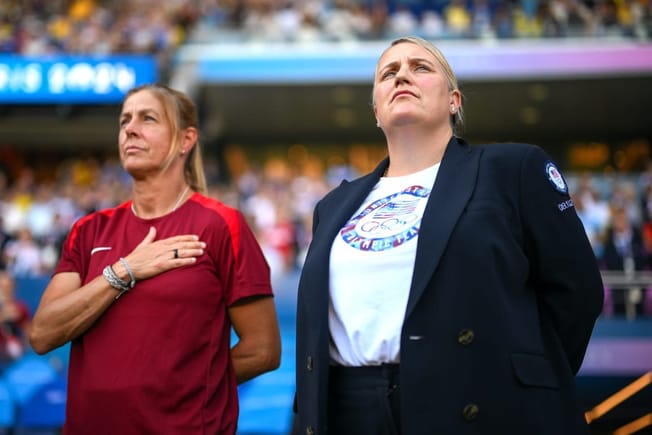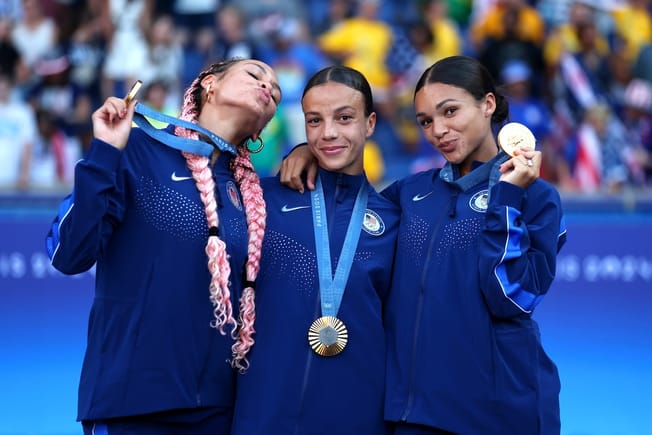Another trophy for the USWNT.
The U.S. women’s national team captured the Concacaf W Championship title on Monday night, taking down Canada in a rematch of their 2021 Olympic semifinal match. Thanks to an Alex Morgan penalty in the 78th minute, the U.S. earned a 1-0 win and officially booked their ticket to the 2024 Olympics.
Let’s talk through some takeaways from Monday’s final.
A HUGE WIN FOR VLATKO ANDONOVSKI
Though this is the USWNT’s ninth Concacaf title, it’s head coach Vlatko Andonovski’s first. Frankly, he needed this win.
After a lackluster Olympics in 2021 where the United States fell short of their gold-medal goal and settled for bronze, there have been plenty of questions surrounding Andonovski. He was criticized for bringing a veteran group to Tokyo instead of integrating younger players into the team at a major competition. That experienced group was supposed to help lead the U.S. to another big tournament victory, but it failed to do so.
Fast-forward to this qualifying tournament and Andonovski clearly took a different approach, at least in terms of personnel. He brought a younger squad to Mexico and was committed to rotating through players to provide meaningful minutes to those with limited international experience.
Since the United States checked all of the boxes at the W Championship by qualifying for the 2023 World Cup and the 2024 Olympics on the way to the Concacaf title, it looks like Andonovski’s approach paid off.
BYPASSING THE MIDFIELD
While Andonovski repeatedly switched his starting eleven to allow younger players to gain experience over the last couple of weeks, he went with a comfortable lineup in midfield against Canada. Andi Sullivan started in the No. 6 position with Lindsey Horan and Rose Lavelle joining her in the middle of the pitch.
Even with that dash of consistency, the USWNT’s midfield struggled to reach its full potential on Monday against Canada. Sullivan was quiet throughout the match and she was rarely involved in the build-up for the United States. She had the fewest touches of the midfield trio, recording just 39 touches compared to Horan’s 62 and Lavelle’s 56.
Sullivan was disconnected from Horan and Lavelle and, as a result, from the USWNT’s attack. Much of that disconnect can be chalked up to the fact that the United States focused on playing long balls whenever they gained possession instead of building through their midfield.
It’s taken the USWNT more than 30 minutes to figure out how to defend in a 4-4-2 mid-block, which is…not great.
— Joseph Lowery (@joeclowery) July 19, 2022
If the United States want to build on and improve from this performance, they’ll need to become more comfortable on the ball and less reliant on forced long passes.
THE ATTACKERS WERE A BRIGHT LIGHT
I really don’t think the scoreline captures the true pulse of this match. They only scored once, but the USWNT dominated for long stretches on Monday.
The United States recorded over double the number of touches in their opponent’s box than Canada, despite both teams logging the same number of passes in the final third. The USWNT also posted an expected goals value of 3.14, which was nearly six times Canada’s total of 0.53 xG.
That expected goals number for the U.S. stemmed from their 17 shots. Horan, Mallory Pugh, and Sophia Smith were especially productive, each recording four shots with two on target for Pugh and Smith.
Despite all of those chances, the USWNT struggled to finish off their attacks. This sequence in the 64th minute really puts that on display. Morgan played an impressive ball in behind the Canadian defense, right into Smith’s path. Smith did some great work to beat Canada’s goalkeeper before slipping and missing the open net.
SOPHIA SMITH MISSES AN OPEN NET FOR THE USWNT. 😱 pic.twitter.com/n8JOqviUXF
— Attacking Third (@AttackingThird) July 19, 2022
While the United States struggled to find the back of the net in this match, their performance proved that they can be dangerous up top when they take space and run at the opposition’s backline. It will be fun to see how the American attack evolves over the next year ahead of the Women’s World Cup.
For now, though, the USWNT will bask in this Concacaf W Championship Final victory having qualified for both the 2023 World Cup and the 2024 Olympics.
All data courtesy of StatsPerform.







Comments